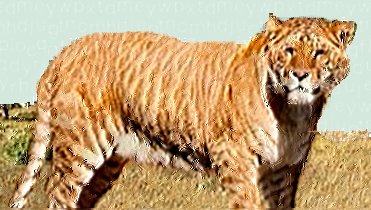Ligers

Ligers - the biggest cats
The genus Felis has cats of a variety of sizes. Perhaps the smallest cat breed that humans regularly come into contact with is the Singapura, an adult specimen of which can weigh as little as two kilograms (4.4 pounds). The other end of the scale is represented by the Liger, largest of the Felis Panthera breed, which is approximately two hundred times heavier - 450 kg, or 1100 pounds. Nor do you have to worry about accidentally shutting a liger into your sock drawer. The beast's head is as wide as an average man's shoulders, and on its hind legs a large liger can easily reach up to twelve feet. |
Cross-breed genetics
That ligers get so large is because of an accident of genetics. As their name suggests, ligers are a cross between lions and tigers. More particularly, they have lion fathers and tiger mothers. 'Hybrid vigour' is often noted in crossbreeds, where the offspring grow both larger and faster than their parents. But with ligers there is more to it than that. Though lions and tigers are genetically close enough to interbreed, one of the differences between the species is that the gene that inhibits growth in tigers is found in the male, and in lions in the female. As a result, the gene that switches off body growth at maturity is absent in ligers, and they just keep growing. This condition is known medically as growth dysplasia, and happens with many species, usually as the result of excessive inbreeding. In some cases it can cause death, when the body grows too large to support itself. Fortunately ligers have only a mild form of the condition, and they merely grow to be the largest cats on the planet - about twice the size of their nearest rival, the Amur (Siberian) tiger, which is itself no small kittycat.
Ligers are very rare. This is because wild animals do not, as a rule, mate outside their own species, and in any case, the wild ranges of lions and tigers do not overlap. So for lion to meet tiger requires a human to introduce them. Even then, most responsible zoos will not encourage the creation of hybrid animals which do not exist in nature. (For the same reason, ligers, as 'artificial' animals, do not have a proper taxonomic latin name.) There is also an ethical issue, in that genetic diseases and cancers are more common in these hybrids, and in any case, liger males are sterile. In fact, ligers are rarer now that they have been for over a century, as they used to be bred by victorian menageries as a commercial attraction. There is even a record from 1837 of a liger being presented to Queen Victoria by an Indian princess. Attempts during the 1930s to create hybrids by artificial insemination were not particularly successful, and the ligers of today are invariably the result of live matings.
Character
Crossbreeding lions and tigers also produces a degree of existiential uncertianty in the beasts themselves. Their handlers have noted that the ligers are sometimes not sure whether to react as lions or tigers in situations where the two breeds would behave differently. One such example is water. Though competent swimmers, lions are not fond of water, whereas tigers positively relish the occasional dip. (now I've mentioned it, given the size, colour and fondness of water shown by Maine Coons, one has to wonder....). Ligers take a while to convince the lion side of their character that water is a good thing, and thereafter generally show their mother's fondness for taking a dip. On the other hand, ligers are social beasts, which is a characeristic which they get from lions which live in prides, rather than from tigers which are usually solitary animals. This tendency toward socialization makes it easier for ligers to be domesticated. However, even though ligers are noted for their 'laid back' character (anything that can swat a Bengal tiger like a fly can afford to take a relaxed view of life) the liger is still a cross between a lion and a tiger, and therefore too dangerous do be considered as a 'tame' pet, even by those who can afford the bill for the six to eight or so kilograms of meat a liger gets through every day. How a wild liger would behave is anyone's guess as the species has only ever lived with humans.
Like any creature, ligers can take more after their fathers or mothers. But almost all ligers can produce both a lion's roar and the chuff sound of a tiger. Though male ligers may have manes, these are modest affairs in comparision with the full mane of an adult lion, and in the same way a liger's stripes are very muted, appearing as a spotty or flame-shaped dappling of the fur, mostly on the rear part of the body. Their size, however is all their own. 'Hobbs', one of the larger ligers, is the offspring of a Bengal tigress and an African lion. He has an estimated weight of between 800 and 1200 pounds and is almost three metres from nose to tail.
Other hybrids
Ligers are the most spectacular, but not only examples of hybrid cats. Tigons are the product of tiger fathers and lion mothers, and inherit two sets of growth inhibitors, which gives them a tendency to dwarfism. Leopards mated with lions have produced leopons, but on the whole, lions and tigers have proven the most successful feline interbreeders. Some female ligers and tigons have proven fertile, though of course these have had to be crossed back with purebreds in the absence of fertile male ligers. The offspring are usually identified by the letters at the start of their names. Thus a li-liger is a liger which has been bred back with a lion, while a ti-liger has been bred back with a tiger. So, for example Ti-ligers and ti-tigons are 75% tiger and so tend to have more of the characteristics and appearance of the tiger. The full table of names is given below.
| Father | Mother | Offspring |
| Lion | Tiger | Liger |
| Tiger | Lion | Tigon |
| Lion | Liger | Li-liger |
| Lion | Tigon | Li-tigon |
| Tiger | Liger | Ti-liger |
| Tiger | Tigon | Ti-tigon |

